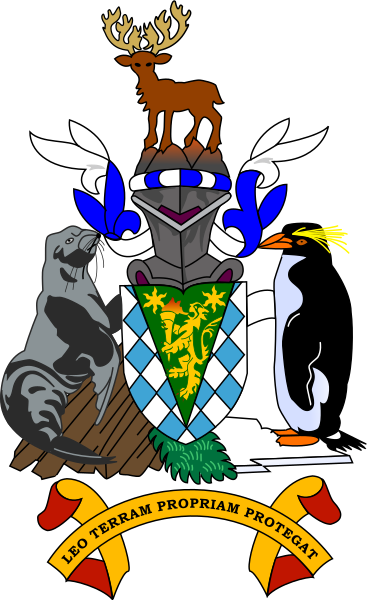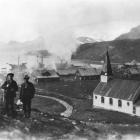
Coat of arms of South Georgia and the South Sandwich Islands.
Coat of arms of South Georgia and the South Sandwich Islands.
Accessed via Wikipedia. Click here to view source.
 This work is licensed under a Creative Commons Public Domain Mark 1.0 License.
This work is licensed under a Creative Commons Public Domain Mark 1.0 License.
The coat of arms of the sub-Antarctic British Overseas Territory of South Georgia and the South Sandwich Islands, located in the Atlantic sector of the Southern Ocean, shows a fur seal and a macaroni penguin as supporters and a reindeer at the crest. While there is an abundance of penguins and fur seals on South Georgia, hopefully not a single reindeer can now be found.
South Georgia was claimed in 1775 by James Cook for Britain, but it took until the early twentieth century before the remote sub-Antarctic island gained any political or economic relevance. When the international whaling industry shifted from the Pacific to the Antarctic waters around 1900 due to the overexploitation of Pacific whale stocks, South Georgia came into the focus of the industry and several whaling stations were established there. In 1904 the Norwegian whaler and explorer Carl Anton Larsen established the Compañía Argentina de Pesca (Argentine Fishing Company) in Grytviken. He started an industry that would become the center of the international whaling business in the following decades. From the beginning, this industry was international. It was an Argentine company operating on British soil, financed by international capital, and staffed mainly by Norwegian seasonal employees. Other whaling entrepreneurs followed Larsen’s example and by 1917 there were a total of six whaling stations on South Georgia. Each station employed several hundred Norwegian seasonal workers during the austral summers. Although the industry was international, it was dominated by Norwegian traditions and culture as can be seen by the whaler’s church in Grytviken or the remains of several ski jumps at the stations. With landscape and climate at least somewhat like northern Norway and no land-based mammals living on South Georgia, Larsen decided in 1911 to bring a first group of reindeer from Norway. The idea behind the introduction was to provide the seasonal workers with a local fresh meat supply and an opportunity to hunt as a leisure activity, an antidote to the strenuous and monotonous work at the whaling stations. A second group of reindeer was brought to the island in 1912 and a third group in 1925. Despite one of the three introduced reindeer herds being eradicated by an avalanche, the animals adjusted quickly to the conditions of South Georgia. The herds grew slowly but steadily. Reindeer hunting became a popular pastime among the whalers and thus the herds did not grow too much, but were de facto effectively managed.

Hunting party at Grytviken in South Georgia, 1925.
Hunting party at Grytviken in South Georgia, 1925.
Unknown photographer, 1925.
Courtesy of Akershusmuseet.
Accessed via Wikimedia. Click here to view source.
 This work is licensed under a Creative Commons Public Domain Mark 1.0 License.
This work is licensed under a Creative Commons Public Domain Mark 1.0 License.
This situation changed completely with the outbreak of World War II and the consequent demise of the South Georgia whaling industry, with the last two stations closing in the mid-1960s. Without the whalers hunting the reindeer, the herd population increased substantially. It was estimated that there were at least several thousand reindeer prior to the beginning of the eradication in 2013. Reindeer occupied at least one-third of the island’s vegetated area. While not a direct threat to the domestic fauna, they competed with the seals when it came to the use of the vegetated areas, which are an important resting area for the various species of seals. Furthermore, global change caused a retreat of glaciers on South Georgia resulting in a situation in which the different herds would no longer be separated by glacier tongues reaching all the way to the ocean. Ultimately, reindeer would be able to roam the whole island, resulting in an expected exponential population growth and thus an even more negative effect on seals, penguins and other birds like the ground-nesting terns. If these animals were to be protected, a solution for the introduced reindeer needed to be found.
Between 2013 and 2015 Norwegian hunters hunted down the complete reindeer population on the island. This operation was carried out by a coalition of marksmen from the Norwegian Nature Inspectorate and Sami reindeer herders. With a total of nearly seven thousand reindeer killed, the result of the hunt was way above the estimates of the reindeer population. Intensive monitoring after the eradication program proved that it has been a success. There were no longer reindeer on South Georgia. Nevertheless, the unique genetic pool of the South Georgia reindeer survived as small numbers of reindeer had been relocated to South America and the Falkland Islands first in the 1970s and again in 2001, where they became the basis of commercial herds, well-controlled and managed.

One of the last reindeer on South Georgia, December 2012.
One of the last reindeer on South Georgia, December 2012.
Photograph by Ingo Heidbrink, December 2012.
 This work is licensed under a Creative Commons Attribution 4.0 International License.
This work is licensed under a Creative Commons Attribution 4.0 International License.
Norwegian whalers introduced reindeer to South Georgia at the beginning of the era of Antarctic whaling and Norwegian hunters eradicated them approximately one hundred years later after the end of commercial whaling operations. Thus, the whole story of the reindeer on the remote sub-Antarctic island of South Georgia was a side-story of the history of whaling on the island. Maybe it is now time for the government of the British Overseas Territory to remove the reindeer from the crest of the South Georgian coat of arms and to replace it with the South Georgia pipit, an endemic bird nearly brought to extinction by another introduced species, the rat. Fortunately, the rats have also been eradicated today, but that is another story.
How to cite
Heidbrink, Ingo. “One Century of Reindeer on South Georgia: From Introduction to Eradication.” Environment & Society Portal, Arcadia (Spring 2024), no. 1. Rachel Carson Center for Environment and Society. https://www.environmentandsociety.org/node/9766.
ISSN 2199-3408
Environment & Society Portal, Arcadia
 This work is licensed under a Creative Commons Attribution 4.0 International License.
This work is licensed under a Creative Commons Attribution 4.0 International License.
2024 Ingo Heidbrink
This refers only to the text and does not include any image rights.
Please click on an image to view its individual rights status.
- Bazilchuk, Nancy. “Reining in Reindeer on South Georgia Island.” Frontiers in Ecology and the Environment 11, no. 4 (2013): 176–76.
- Burton, Robert, and John Croxall. “History of Exploitation.” In A Field Guide to the Wildlife of South Georgia, 16–19. Princeton: Princeton University Press, 2012. doi:10.2307/j.ctv1nxcv62.7.
- Isachsen, Gunnar. “Modern Norwegian Whaling in the Antarctic.” Geographical Review 19, no. 3 (1929): 387–403. doi:10.2307/209147.
- Leader-Williams, Nigel. Reindeer on South Georgia: The Ecology of an Introduced Population. Cambridge: Cambridge University Press, 1988.
- Leader-Williams, Nigel, D. W. H. Walton, and P. A. Prince. “Introduced Reindeer on South Georgia—A Management Dilemma.” Biological Conservation 47, no. 1 (1989): 1–11. doi:10.1016/0006-3207(89)90016-5.
- Poncet, Sally, and Kim Crosbie. “A Brief History of South Georgia.” In A Visitor’s Guide to South Georgia: Second Edition, 31–41. Princeton: Princeton University Press, 2012. doi:10.2307/j.ctv1nxctzz.8.








